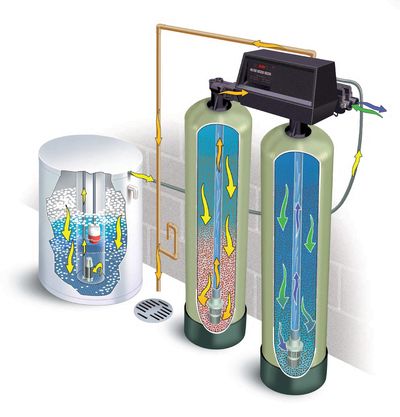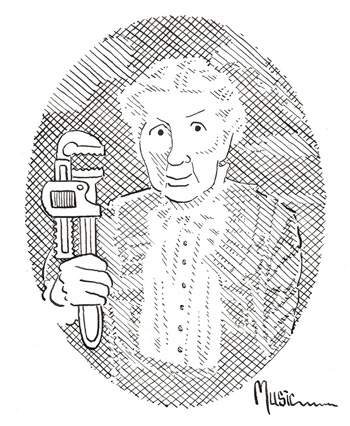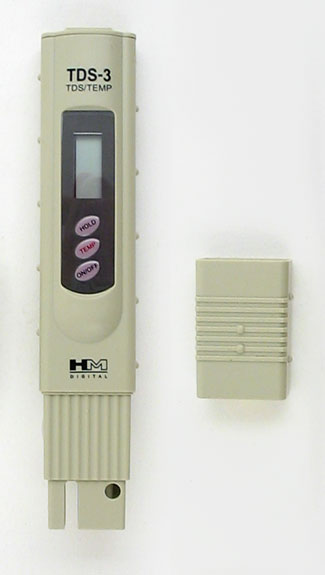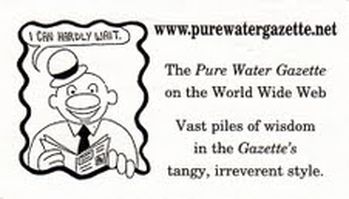Special Mid-Month Issue December 15, 2012 |
|---|
We hope you'll read the Pure Water Gazette's new "Today's Top Water News" section. New articles appear daily. Some examples of recent posts are included in his issue. |
In the News
As Carbon Dioxide Increases, Oceans Become More Acidic. The State of Washington Has Decided to Take Action.
The oceans have long acted as a sink for carbon emissions. Now they are being asked to absorb more than they can handle.
The result is ever increasing acidification. Seawater is steadily becoming more corrosive. Many coral reefs have already been destroyed and in many areas of the ocean the entire food chain is threatened.
The State of Washington is particularly concerned about growing ocean acidification because increasing acidity is a major threat to the state’s important shellfish industry. Shellfish, especially oysters, are prevented from developing shells by an acidic environment.
The only long-term solution for acidification is for the world to reduce industrial emissions of carbon dioxide, but since this is clearly not going to happen overnight, Washington is attempting to “buy time” by slowing the process.
Here is how the plan works:
The first step will be to monitor ocean acidity with greater breadth and accuracy and to create an acidity budget — an assessment of just how much acidity is contributed by whom. Next it will seek to reduce carbon pollution from land-based sources, including agricultural and urban runoff. There will also be practical, site-based steps to offset carbon, like planting sea grasses (which themselves are endangered globally) in shellfish hatcheries. And there will be an extensive campaign to educate the public, business leaders and policy makers about the risks of increasing acidification.
The state has set aside $3.3 million to begin the effort (much more will be required down the line), and the National Oceanic and Atmospheric Administration will help with its laboratories.
The important thing about the program is that it is a start. Waiting for the world to change is not a practical strategy.
Reference: New York Times.
Real Christmas Trees Are the Green Choice
by Teresa McUsig
An Introductory Note by Hardly Waite.
Would You Rather Be Cremated in a Factory or Buried Under a Christmas Tree?
Daily we face environmental choices that have no clear answer. Paper or plastic at the grocery store is a good example. The Christmas tree dilemma discussed in the article below has already been aired in the Gazette. We first printed Real Christmas Trees Are Second Only to No Tree At All, which was quickly answered by staff writer Tiger Tom in his snarly essay In Defense of Phony Plastic Christmas Trees.
When all the arguments are in, I’ll confess that although I would run away fast if someone tried to give me a Christmas tree, I side with the real tree people. I feel this way for the same reason that I think cemeteries aren’t such a bad thing. A friend who prefers cremation to burial as a more environmentally sound way of getting rid of dead people says that cemeteries are a waste of land. May be, but would the land be better used if we instead put up parking lots or convenience stores? Cemeteries, after all, usually have trees and plants and peace and quiet and don’t produce a lot of noise or noxious fumes or light pollution. The world would be a nicer place with more cemeteries and fewer freeways. Same with Christmas tree farms, I say. A tree farm is better use of land than a factory, and Christmas trees are no more useless than most of the things we spend our money for. --Hardly Waite, Pure Water Gazette.
The piece below, by Arlington, TX-based writer Teresa McUsic, is reprinted here from an email newsletter published by Green Source DFW.
The holidays are a time for lots of buying decisions, which makes it a perfect time to go green. What better way than to start with the tree.
Many consumers still face the annual question of whether it is better for the planet to cut down a real tree or buy an artificial one. But Will McClatchey, vice president of research at the Botanical Research Institute in Fort Worth, said there is little room for debate—real trees are better. “Absolutely, for lots of reasons,” said McClatchey, who has his PhD in evolutionary biology.
McClatchey’s assessment is backed up by several studies, most notably one from Canada that shows consumers must hold onto a fake tree for 20 years before it equals the environmental impact of a real tree. Unfortunately, North Americans keep their fake trees for just six years, according to the study by Ellipsos, a sustainability development consultant in Montreal. Using the six-year framework, the amount of carbon dioxide emission is much higher for artificial trees.
“The hot topic these days is climate change,” the study reads. “When looking at these impacts, the natural tree contributes to significantly less carbon dioxide emission (39%) than the artificial tree.” The study can be read here.
More than 30.8 million trees will be cut for Christmas trees this year, according to the National Christmas Tree Association. Natural trees sales outpace artificial trees 3 to 1, the association said. And most consumers—31 percent–buy their trees at local farms, according to a survey by the association.
 |
|---|
| Christmas Tree Farms Are Relatively Harmless Agriculture |
But in North Texas you better act fast. The 2011 drought has still reduced the number of trees available and many households have already been out buying. Jim Wilson, owner of Main Stay Farms in Cleburne, said he has sold almost all of the 400 trees tagged to be cut this year from his farm of 6,000 trees. “We had hordes of families here the weekend after Thanksgiving when we first opened,” he said. “We’re down to our last 10 percent of trees available to cut.”
Wilson said he still had some Virginia Pine and Leyland Cypress available, as well as around 300 of the 550 Frasier firs he had shipped from North Carolina. Next year, he will begin selling a new tree for cutting, a white-barked Arizona Cypress.
“I ordered 1,400 of the trees for planting and they’ll be ready next year,” he said. “The tree is really pretty and doesn’t take as much water to grow.”
The 2011 drought slowed down some of his tree production, which usually allows for around 700 trees to be available each season, he said. It takes about six years to grow a tree to the holiday size, he said.To find a local farm for your Christmas tree, put your town or zip code into a directory available by the Christmas Tree Association at www.christmastree.org. Wilson advises buying a tree that does not sit out in the Texas sun after being cut. After buying, cut ½ inch off the trunk and soak in water. Once inside your home, water daily and keep always from heat vents.
Twin Tank Water Softeners: An Underappreciated Residential Product
One of the most underrated "green" products available is the twin tank water softener. Although the initial cost is more, twin softeners can pay for themselves in water and salt savings. They also offer the satisfaction of being the most environmentally friendly of conventional water softeners.
A twin softener is essentially two identically-sized water softener resin tanks joined and controlled by a single softener valve. The control valve can be either a timer or a metered regeneration style, with metered being strongly preferred for this type softener.
To dispel a common misconception about twin softening units, the two tanks work one at a time. That is, you don't get double softening. A single softener tank is more than adequate to reduce the hardness of most residential water to virtual zero. The twin unit operates by keeping one of its tanks in reserve. When the capacity of tank one is reached, the control valve immediately puts tank two into service, so that there can never be a time when hard water is being sent to the home, as can happen with single tank softeners. Even when a tank is being regenerated, soft water is being delivered to the home. And, unlike the single tank unit, twin units use soft water for regeneration.
Since the switch from one tank to the other can be made at any time of the day or night, no "reserve" needs to be programmed into the softener. With conventional one-tank units, a certain amount of the tank's capacity--usually about one day's expected usage--is always held in reserve. This is accomplished by simply programming the softener to regenerate a day early. By conservative estimate, this "reserve" requirement is responsible for about 15% of the salt and water used by a single-tank softener. Simple arithmetic tells you that if a softener that regenerates once a week always regenerates one day early, in a year it will simply throw away 48 days worth of its softening capacity. And what is really being tossed away is water and salt.
Applications
Twin tank units are especially good for applications that require a long, uninterrupted supply of soft water. For example, if a softener is used to pretreat hard water for a large reverse osmosis unit, it is difficult to assure that the reverse osmosis unit will not demand water when the softener is regenerating. A twin tank unit solves this problem by providing a never ending supply of soft water.
One of our local customers is a yogurt store that needs to protect its expensive yogurt machines from scaling. Yogurt machines run around the clock and it would be very impractical to turn them off so that a conventional water softener can regenerate its resin bed. A twin softener is a perfect solution. It provides an endless supply of treated water with fully automatic operation with no need to maintain a "reserve."
 |
|---|
| Twin Softener with brine tank. When one tank is exhausted, the control valve immediately switches the home's service flow to the other. |
Twin softeners are the most water and salt efficient softeners made. They regenerate less frequently because no "reserve" capacity has to be calculated. They have the added advantage of performing the regeneration with softened water, assuring a cleaner and more complete regeneration. Twin softeners are especially useful for applications requiring long service cycles that need an uninterrupted supply of soft water.
Twin softener availability and pricing.
A Case of Health of Many vs. Wealth of a Few: A Hard Look at Horizontal Fracking
Editor’s Note. The following description of the practice of fracking, excerpted from Why the War Against Fracking May Be Our Most Crucial Conflict by Ellen Cantarow, underlines the seriousness of the practice of horizontal fracking. The author's insistence that fracking may be "our most crucial conflict" makes you wonder why hydraulic fracturing was not a central topic of contention in the recent election debates. Did you hear the President or his opponent utter a single word on the topic of fracking? What are your legislative representatives' views on fracking? Why is it being left to . . ."farmers, physicists, journalists, teachers, librarians, innkeepers, brewery owners, and engineers" to stand up to the wealthiest one percent who see fracking only as a fat dollar sign? --Hardly Waite.
Developed in 2008 and vastly more expansive in its infrastructure than the purely vertical form of fracking invented by Halliburton Corporation in the 1940s, high-volume horizontal hydraulic fracturing is a land-devouring, water-squandering technology with a greenhouse gas footprint greater than that of coal. The process begins by propelling one to nine million gallons of sand-and-chemical-laced water at hyperbaric bomb-like pressures a mile or more beneath Earth’s surface. Most of that fluid stays underground. Of the remainder, next to nothing is ever again available for irrigation or drinking. A recent report by the independent, nonpartisan U.S. Government Accountability Office concluded that fracking poses serious risks to health and the environment.
New York State’s grassroots resistance to fracking began about four years ago around kitchen tables and in living rooms as neighbors started talking about this frightening technology. Shallow drilling for easily obtainable gas had been done for decades in the state, but this gargantuan industrial effort represented something else again.
Anthony Ingraffea of Cornell University’s Department of Engineering, co-author of a study that established the global warming footprint of the industry, calls this new form of fracking an unparalleled danger to the environment and human health. “There’s much more land clearing, much more devastation of forests and fields. . . thousands of miles of pipelines. . . many compressor stations [that] require burning enormous quantities of diesel. . . [emitting] hydrocarbons into the atmosphere.” He adds that it’s a case of “the health of many versus the wealth of a few.”
Against that wealth stands a movement of the 99% — farmers, physicists, journalists, teachers, librarians, innkeepers, brewery owners, and engineers. “In Middlefield we’re nothing special,” says Kelly Branigan, a realtor who last year founded a group called Middlefield Neighbors. “We’re just regular people who got together and learned, and reached in our pockets to go to work on this. It’s inspiring, it’s awesome, and it’s America — its own little revolution.”
.
Fifteen Million Americans Now Suffer From Food Allergies: Pesticides in Tap Water May Be the Cause
Editor’s Note: The following is excerpted from an excellent article by Sarah Glynn published in Medical News Today. We would add that the persistent presence of dichlorophenols in tap water provide a strong argument that every home should have an effective carbon drinking water filter. — Hardly Waite.
The finding was published in Annals of Allergy, Asthma and Immunology, the scientific journal of the American College of Allergy, Asthma and Immunology (ACAAI), and came from a team of experts led by Elina Jerschow, M.D., M.Sc., ACAAI fellow and allergist.
According to the researchers, high levels of dichlorophenols, a chemical used to chlorinate water and also used in pesticides, is linked to food allergies when it is found in a person’s body.
Dr. Jerschow explained:
Our research shows that high levels of dichlorophenol-containing pesticides can possibly weaken food tolerance in some people, causing food allergy. This chemical is commonly found in pesticides used by farmers and consumer insect and weed control products, as well as tap water.
Data of 10,438 people from the United States National Health and Nutrition Examination Survey 2005-2006 was analyzed for purpose of the study. Dichlorophenols was found in the urine of 2,548 subjects, but 2,211 were further observed.
Results showed that 411 of the 2,211 analyzed had a food allergy, and 1,016 had an environmental allergy.
Dr. Jerschow said:
Previous studies have shown that both food allergies and environmental pollution are increasing in the United States. The results of our study suggest these two trends might be linked, and that increased use of pesticides and other chemicals is associated with a higher prevalence of food allergies.
Although drinking bottled water may seem less risky for developing an allergy than drinking water from the tap, the results from this research indicate that making the switch to bottled water may not be effective in preventing allergies.
“Other dichlorophenol sources, such as pesticide-treated fruits and vegetables, may play a greater role in causing food allergy,” added Dr. Jerschow.
Between 1997 and 2007, food allergy increased by 18%, according to the CDC (Centers for Disease Control and Prevention).
A previous report, published in Journal of Allergy and Clinical Immunology, found that 7.5 million Americans have at least one food allergy, and young black children seem to be at the highest risk.
The most frequently reported food allergens are:
- peanuts
- tree nuts
- wheat
- milk
- eggs
- soy
- shellfish
- fish
In Our Age of Information, Information About Fluoride and IQ in Children Is Hard to Find
by Hardly Waite, Senior Editor
 |
|---|
| There have now been 36 major studies that link fluoride with lower IQ in children. "Fluoride, it appears, makes children dumber." |
An October 2012 publication of research done at the Harvard University Department of Environmental Health surveyed numerous previous studies and reached the conclusion that ingesting fluoride has an effect on children’s neurodevelopment and that, in fact, “. . .children in high fluoride areas had significantly lower IQ scores than those who lived in lowfluoride areas.”
The sad thing about the finding is that you probably aren’t going to read about it in your local paper or hear about it on the evening news. A Senate committee isn't going to hold hearings. And what’s doubly sad is that it isn’t news at all. The Harvard researchers (Anna L. Choi, Gufian Sun, Ying Zhang, and Phillippe Grandjean) made no startling discovery on their own. They simply reviewed the findings of many, many previous studies that have shown similar results but have also failed to be reported on the evening news.
Fluoride Action Network had identified at least 36 previous studies that came to the same conclusion. Michael Connett and Tara Blankwrite:
As of September 2012, a total of 42 studies have investigated the relationship between fluoride and human intelligence, and a total of 17 studies have investigated the relationship [between] fluoride and learning/memory in animals. Of these investigations, 36 of the 42 human studies have found that elevated fluoride exposure is associated with reduced IQ, while 16 of the 17 animal studies have found that fluoride exposure impairs the learning and memory capacity of animals. The human studies, which are based on IQ examinations of over 11,000 children, provide compelling evidence that fluoride exposure during the early years of life can damage a child’s developing brain.
The relationship between fluoride and the dumbing down of children isn’t new and it isn’t secret. It is surprising, though, how few people are aware of it. The next time your dentist speaks out for fluoridation of the public water supply, ask him if he’s aware of the Harvard research showing that fluoride has a demonstrable bad effect on the neurodevelopment of children. If he tells you the Harvard study is part of a commie plot to destroy America's teeth, look for a new dentist.
Reprinted from the Pure Water Gazette.
Early December Water News
The Pure Water Gazette features top water news story each day. Here's what you missed in the first half of December if you haven't been reading the Gazette:
The new Gazette format also indexes much of the significant content of the old online and paper versions of the Pure Water Gazette. Take some time to browse. As our ad says, you'll find "Vast piles of information in the Gazette's tangy, irreverent style."
 |
Common Tools for Home Reverse Osmosis Maintenanceby Pure Water AnnieTechnical Wizard Pure Water Annie Describes What You Need to Take Care of a Home RO Unit |
|---|
Simple, Inexpensive Tools and Supplies for RO Service. You Already Have Most of These.
Undersink reverse osmosis units sometimes look frightening to those unfamiliar with them, but once you catch on to how they work you’ll find they’re pretty easy to take care of. As with most self-care items, having a few basic tools makes things easy. Opening a can is a complicated job without a can opener, but it’s very simple if you have one. A few simple tools make RO maintenance as easy as opening a can of soup.
Most RO units come with a filter wrench. For most systems, you’ll need the wrench to open and tighten the filter housings when you change filter cartridges. Best source: Online water treatment websites. Make sure you get one that fits the housings on your unit.
Owning a TDS tester isn’t essential, but a good TDS meter a very important diagnostic tool. For one thing, it can tell you when the RO membrane needs to be replaced. Owning a simple hand-held tester can save you money because it takes the guess work out of assessing the condition of the membrane. Membranes often last for many years, so simply following the manufacturer’s suggested change schedule can create lots of unnecessary expense. (There is never an reason to replace an RO membrane that is performing well.) The tester tests the TDS, “Total Dissolved Solids,” of the RO water, which is the most practical way to assess the performance of the membrane. Best source: Online water treatment websites.
 |
|---|
| A Modern Total Dissolved Solids Tester Gives You An Instant Picture of the Effectiveness of Your RO Unit. You Can Also Use It to Test Your Tap Water for Comparison. |
A bicycle pump, or the equivalent, is an almost essential tool. You will need periodically–once a year is a good rule of thumb–to add air to the RO storage tank. A small compressor will work, but a hand pump works better. RO tank bladders aren’t as hardy as auto tires, and they are often ruined by adding air too fast. The bicycle pump is a perfect tool for the job. A related tool is a low pressure air gauge. You need a gauge that accurately measures pressures below 10 psi. Most regular “tire gauges” aren’t accurate at these pressures. Best source: Your local hardware store or an online hardware hardware merchant.
Common items that you already have are also effective tools. A towel placed under the unit before you work on it will catch drips and keep your floor dry. A flashlight is the best leak-finding tool known. And when you finish your service job, looking over your unit’s fittings with a bright flashlight will let you find small leaks you might otherwise miss.
More Information:
Using a TDS Tester to Test Your RO Membrane
A good source of parts and RO tools.
.
Gazette Numerical Wizard B. Bee Sharper Tells Her Unique Version of A Story You Know Well. |
 |
|---|
The Number of Nights Before Christmas that ‘Twas: 1
by B. Bee Sharper
Editor’s Note: Pure Water Gazette numerical wizard B. Bea Sharper writes only in the Harper’ s Index number format. This makes fiction difficult, but you’ll see that she carries it off well in the piece below. If you prefer the Gazette version, with text in full holiday colors, read it here. – Hardly Waite.
Number of nights before Christmas that ’twas: 1
Number of creatures, including mice, that were stirring: 0.
Stockings that were hung by the chimney with care: 16
Approximate number of visions of sugar plums dancing in Timmy’s head: 43.
Time when Timmy settled down for his long winter’s nap: 10:30.
Number of clatters that arose on the lawn: 1.
Total number of miniature sleighs seen by Timmy when he tore open the shutters and threw up the sash: 1
Number of tiny reindeer that were pulling the sleigh: 8.
Exact number of little old lively and quick sleigh drivers seen by Timmy: 1
Number of little round bellies the lively and quick sleigh driver with a nose like a cherry had: 1.
Total number of toys he had in his bundle when he came down Timmy’s chimney: 176.
Number of stairs Timmy quietly crept down in order to watch Jolly Old St. Nick go about his work: 14.
Number of times you’ll have to click on this conclusion to the story link to find out what happened next: 1.
Thanks for reading and
Happy Holiday from Pure Water Products, the Pure Water Gazette, and the Pure Water Occasional.
Here are some sections on the Occasional's website that you will want to visit:
Links to Pages about Water and Water Treatment
New Products from Pure Water Products
Pure Water Annie's Glossary of Water Treatment Terms
The Pure Water Occasional is a project of Pure Water Products. Please visit our websites: Main Website: www.purewaterproducts.com This site features our full range of products, plus instructions, technical articles, product manuals, and more. The Occasional's Website: www.purewateroccasional.net. In addition to archiving back issues of the email Occasional, this site houses a sizeable section about water contaminants, a "how things work," series, a new products section, a glossary of water treatment terms, and, "much, much more." Other Pure Water Products Sites: www.purauv.com To contact us by phone, please call 940 382 3814.
|
|---|

